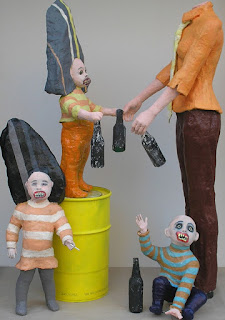Paintings from the series
"The Infantilizators" are populated by the contemporary consumer-men,
individuals shocked by the surrounding reality, overwhelmed with an excess of
stimuli, their faces frozen in a bizarre grimace combining greed and
surprise. Goggleeyed and with bared teeth, the characters resemble zombies -
hypnotized creatures, stripped off any free will or conscience, automatically
responding to external stimuli. In case of infantilizers, the stimuli are of
course audio-visual and come from the mass media, billboards and shop windows
attacking the consumers from all sides with offers of yet another product
without which our lives will surely be deficient. Interestingly enough, all
this takes place against a plain background of homogeneous color. The
whole abundance of products is usually reduced to a single item - the
character's facial expression reveals the rest.
Perhaps not coincidentally, the title of the series
brings to mind Benjamin R. Barber's book Consumed: How Markets Corrupt
Children, Infantilize Adults, and Swallow Citizens Whole, which is an attempt
at a critical analysis of the socio-economic situation in the Western
World. As Barber points out, large corporations ensure that they reduce adult
consumers of goods and entertainment to children who easily act upon the
impulse to own, and that children themselves are raised to be ready-made
consumers never allowed to confront their infantile id ruled by the pleasure
principle and determined to satisfy its basic drives. A similar thought
can be found in Albert Oszek's paintings, whose subjects include adults with child-like
mentality, or children whose ability to critically assess the usefulness of
material goods is disabled at the early stages of development.














